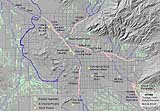
| ch. 5, pp. 62 - 64 |
Establishing Riparian Areas & Creating Wetlands Water can be used to create wetlands off the stream or to establish vegetation and habitat in the stream channel itself. A stream, however, needs more than water to form a healthy riparian area. A stream in its natural state tends to meander and over time changes its course over a wide flood plain. Cottonwoods may germinate along a new channel, while mature cottonwoods still grow along an old channel. Terraces tend to form and different vegetation is found on successively higher terraces. These conditions often are not possible in a populated area such as downtown Tucson, where buildings exist along the banks, and flood control structures constrain the river within a narrow channel. Where the stream channel is in a relatively natural state, as is the case with many washes, restoration does not pose great difficulties. The addition of water may be all that is needed. The Rillito Creek at Craycroft Road, for example, had a lush cottonwood and walnut forest until very recent times. Pumping has depleted the aquifer to the point that the trees are stressed. Cessation of pumping would probably very quickly lead to restoration of a vigorous riparian habitat. Similarly, the Tanque Verde and Pantano washes have areas where pumping has lowered the water table, but conditions are still good for restoration if pumping levels decline significantly. When water was added to the Santa Cruz River north of Nogales, the riparian vegetation came back quickly. The river in that area is shallow, and a broad flood plain stretches out on both sides of the river where flood waters can spread out onto farm land and meander in changing channels. The Santa Cruz River between El Camino de l Cerro and Ina Road has a riparian habitat dominated by willows. Effluent from the Roger Road Wastewater Treatment Plant waters this area. Where the stream channel is deeply incised, however, and/or where the banks have been stabilized to prevent erosion, establishing a riparian area is much more difficult. The Santa Cruz River, through the downtown Tucson area, is not only deeply incised, but has soil cement on both sides of the river, keeping the waters within steep banks. This part of the river is no longer conducive to spontaneous development of cottonwood willow forests merely by creating a flow. In the San Xavier District, the U.S. Bureau of Reclamation built a rock structure to encourage the growth of riparian trees within the channel along one side of the river, even though the banks are steep and subject to erosion. Downstream of the downtown area, effluent from the wastewater treatment plants supports a small riparian area, that is interrupted, however, by bank protection. The Rillito Creek, similarly, is incised and has bank protection along much of its length. The best possibilities for riparian habitat ar e probably in the upstream areas and along certain washes. Tucson Area Riparian Restoration Projects A number of water-based projects which have riparian restoration benefits are being developed or considered in the Tucson area. Many of these projects involve one or more governmental entities and are included as part of the City of Tucson’s “Multiple Benefits Water Projects” or County’s “Sonoran Desert Conservation Plan.” Figure 5-18 shows a number of the current and proposed projects, extending from Pima Mine Road to Marana and from Avra Valley to Tucson’s east side. In some cases proposals are being developed jointly by the city and county and are included in both plans. The county’s water-related restoration projects include a recharge project along the Santa Cruz River in Marana that will enhance the riparian area by using treated wastewater. A proposed project will restore a higher water table along the Rillito. A detention basin along Arroyo Chico at Park Avenue is to provide urban wildlife habitat through alteration of the current flood control structures. Additional proposed projects include restoration of riparian habitat along the Cañada del Oro using CAP water.
Tucson’s Multiple Benefit Water Projects include a number of water-based projects which would provide recreational opportunities, wildlife habitat as well as recharge of groundwater. Four of the recharge projects have essentially no restoration component (Central Avra Valley, Pima Mine Road, Rillito Recharge Project, and Santa Cruz Managed Underground Storage Facility). The Sweetwater Wetlands, which has a rich habitat, is a constructed wetland located a slight distance from the Santa Cruz River channel. The Atturbury Project uses reclaimed effluent for riparian habitat restoration. The Kino Sports Park involves a lake incorporated into a golf course area, while the Silverbell Driving Range Project involves a small constructed wetland to treat restroom water. The Tucson Airport Remediation Project is a pollution remediation facility, and its water could be made available for riparian habitat development along the Santa Cruz River. However, community approval would be needed and legal constraints surmounted. Three projects are primarily stream restoration (Rillito Creek, Santa Cruz River, and San Xavier). The Rio Nuevo Project near downtown Tucson is also part o f this plan. If the city decides to dedicate a portion of its CAP allocation to habitat establishment, long-term community support is needed. An increase in population could eventually justify using the entire CAP allocation to serve human needs. Whether the Tucson community would agree to this reallocation or would insist that a portion of the city’s CAP allocation continue to be used to maintain riparian areas is unclear.
|

